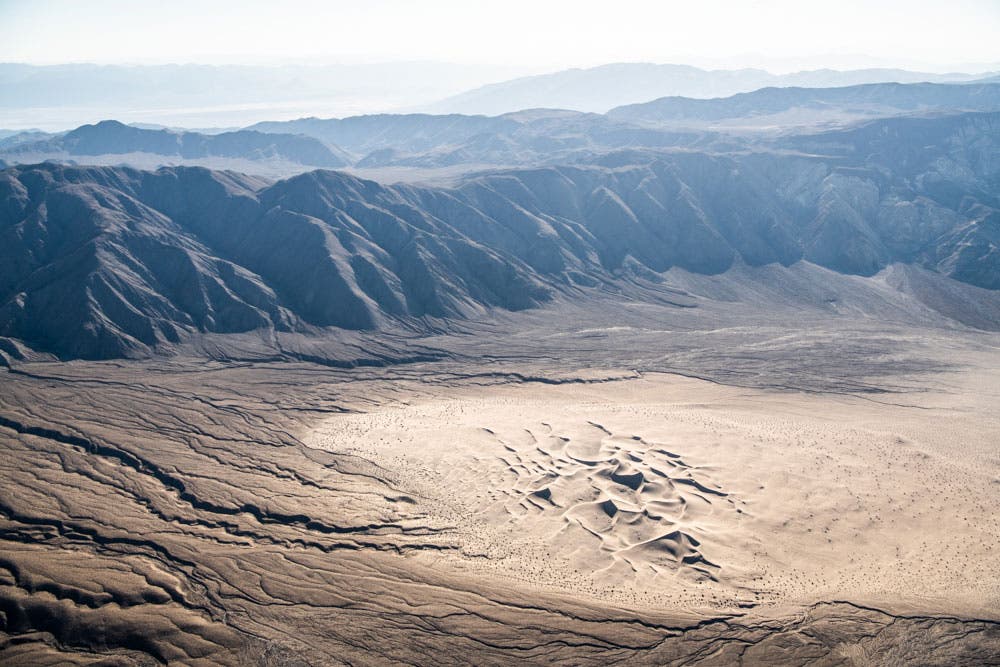Recently I linked up with my good friend and world class landscape photographer Paul Hoelen for a mission to take aerial photographs in the Mojave and Great Basin Deserts of Southern California. Our target destinations were Owens Lake, Searles Lake, and Death Valley National Park, and while I have previously visited and photographed this region from the ground, nothing could prepare me for what we would see during our three days of flying.
Owens Lake is located in the Owens Valley, and is situated on the southeastern side of the Sierra Nevada Mountains. In 1913, water from the Owens River was diverted through aqueducts to Los Angeles and within a few years, the lake was dry. And now the lakebed is a salt pan and its surface is made of a mixture of clay, sand, and a variety of colorful minerals.


Searles Lake, which is just a few miles to the southeast, is an endorheic dry lake meaning that it is has no outflow and equilibrates through evaporation. Like Owens Lake, it is rich with the same types of minerals. All of this may not sound that interesting, but once you are above them looking down, it quickly becomes clear as to why they are such unique and fascinating landscapes.
Death Valley National Park occupies an interface zone between the Great Basin and Mojave deserts and is a diverse environment of salt-flats, sand dunes, badlands, valleys, canyons, and mountains. It is one of the hottest and driest places on earth and the second-lowest point in the western hemisphere is Badwater Basin at 282ft below seal level. The park’s unique geology is a fascinating study from any angle but what we found when flying over really blew us away.
Gear and lens choices:


I am a Nikon shooter and for this project I used a D850 and several lenses including a 24-70mm f2.8 ED VR, 70-200mm f2.8 ED VR II, and a 105mm f2.8 Micro VR. Because we were flying at various altitudes and above varied terrain it was nice to have the versatility of the zoom lenses, which I used for a lot of the images I created.
I do, however, prefer using prime lenses when feasible as they are typically sharper than zoom lenses and this is really important when using a high-resolution camera like the Nikon D850. Like any shoot, you often have to compromise between certain lenses and gear with what is practical for the logistics of your project. Because we were in a small plane it was important to keep our kits light and versatile thus determining my lens choices described here.
Shutter speed and exposure settings:

When shooting from a moving aircraft there are a number of factors to address to ensure you are getting sharp images. In this case we flew in a Cessna 172 Skyhawk. It is a tried-and-true aircraft and very common so you see them used quite often for aerial
photography.
In our case, we were flying at an average of 122knots or 140mph, and which, at times, can be pretty bumpy with turbulence. With the speed of flight and shaking from the machinery, as well as the wind factor, it poses a real challenge to capture a sharp picture. This means you need a high shutter speed. And if you want a sharp image edge to edge using the best part of your lens then you are typically set around an aperture of f8. (This is all being discussed in the context of using a full frame DSLR).

In this scenario I was looking for a minimum shutter speed of 1/1000sec and an aperture of f/8 for the lenses I had. And, of course, I want to use the lowest ISO possible to maximize image quality. Like with any shoot, there are compromises and you will have to choose the appropriate settings given the conditions. There are also options such as using a gyro stabilizer that can assist in reducing the vibrations from the aircraft. A lot of lenses have built-in stabilization which can help in some cases.
But above all, remember that each scenario poses its own unique challenges which are important to understand prior to your shoot so that you can choose the appropriate equipment for success.






